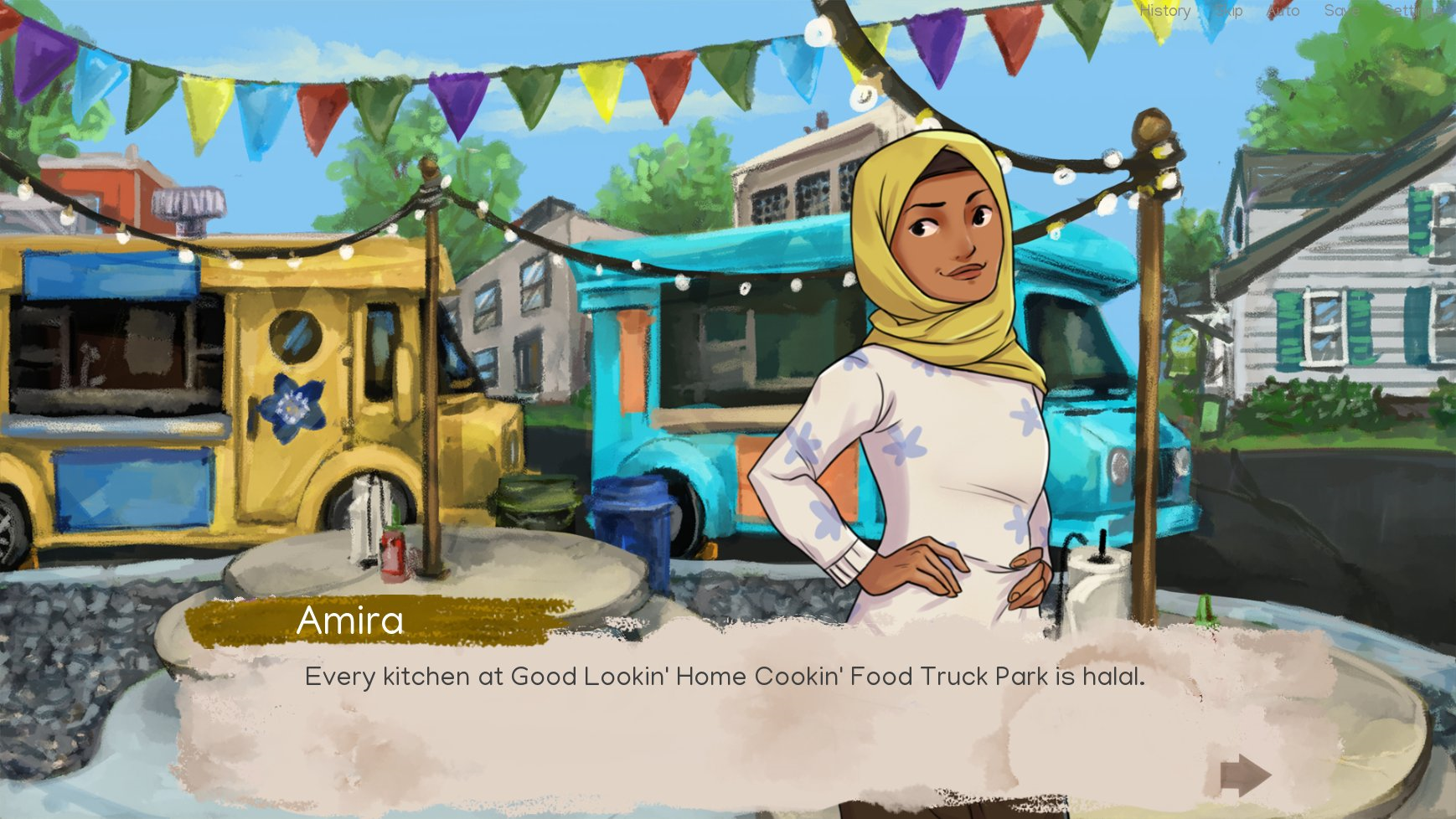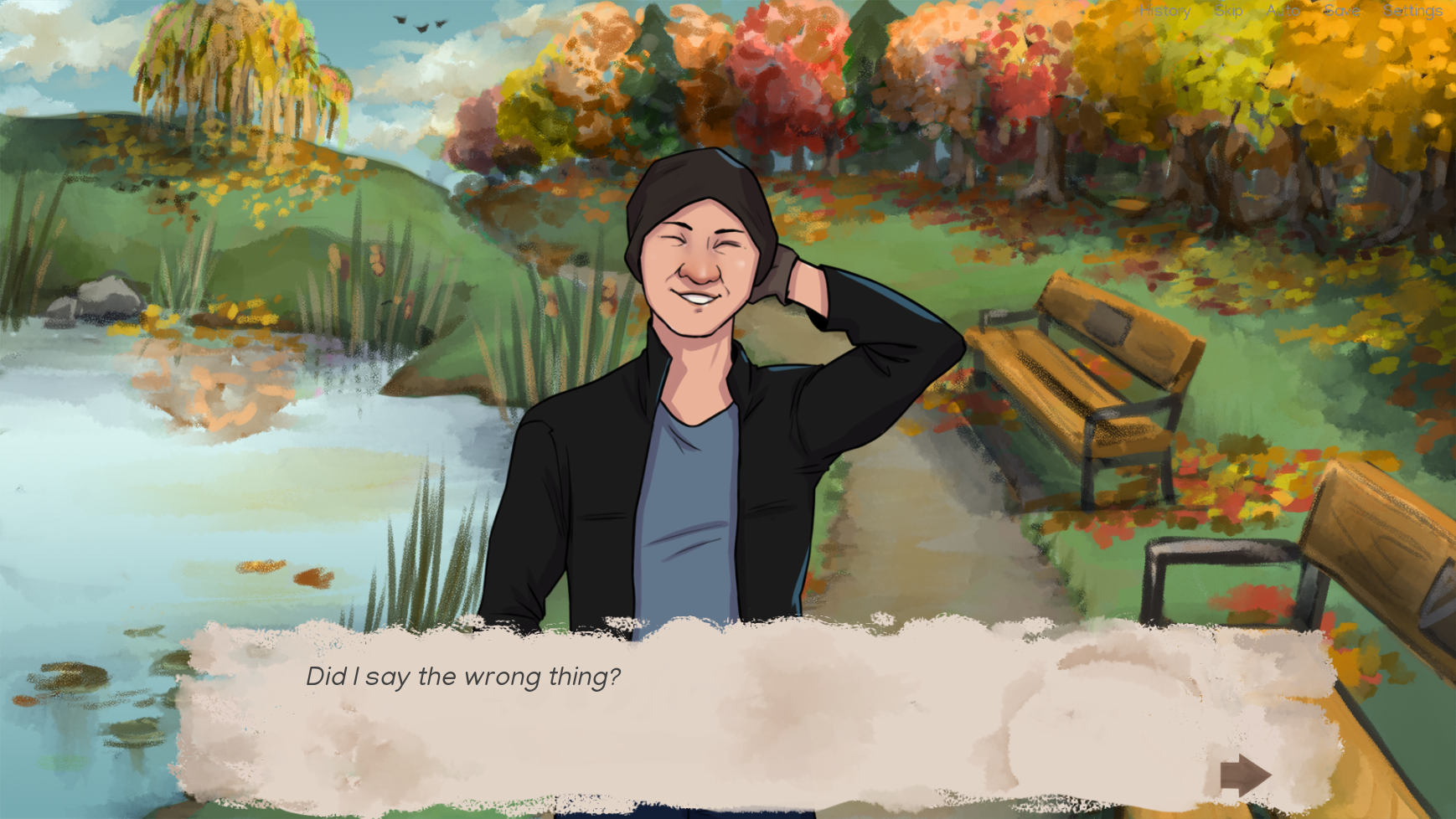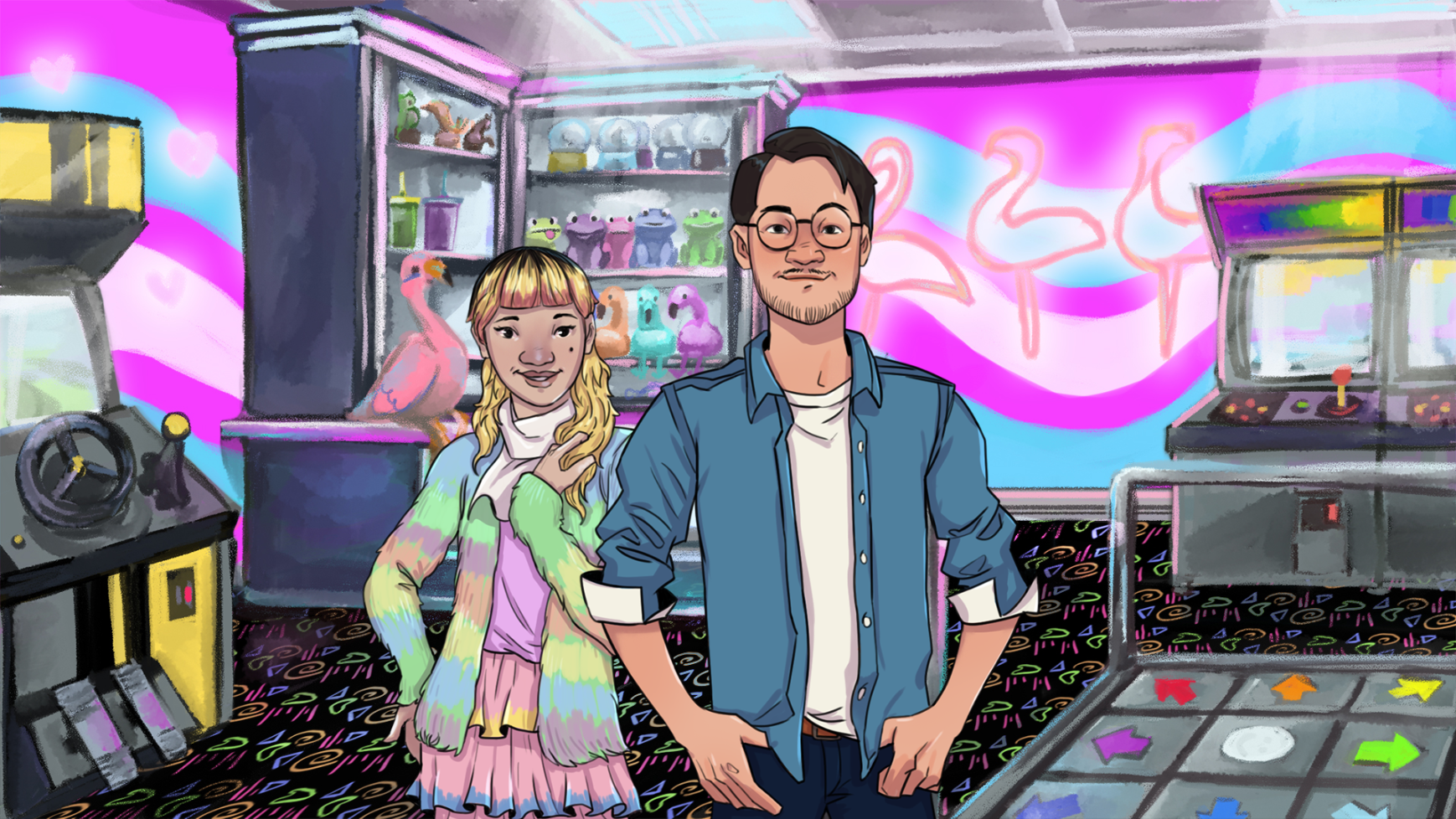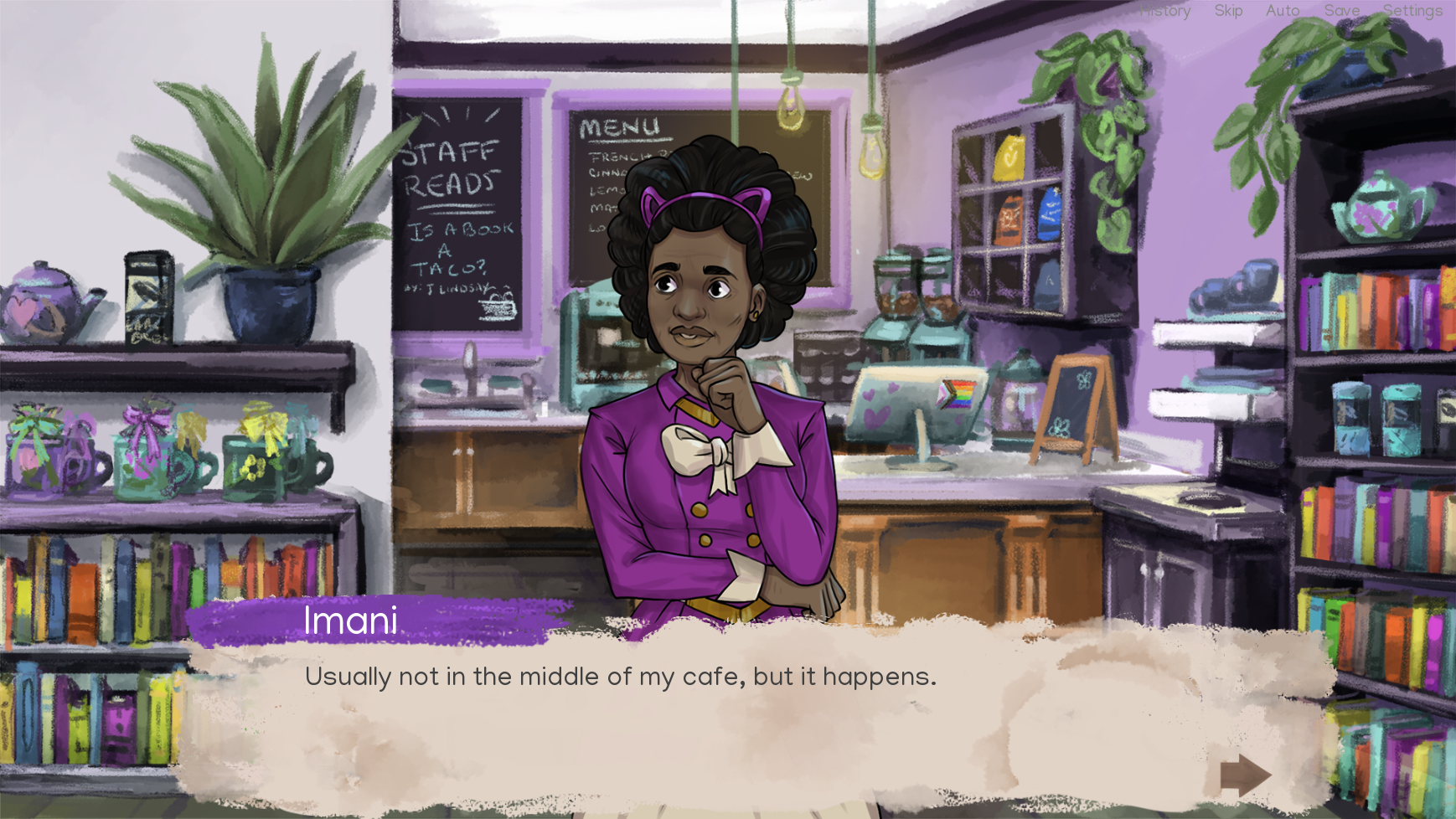After playing Good Lookin’ Home Cookin’, I knew that I absolutely needed to talk to the creative team behind this beautiful game and what’s coming next in the Call Me Cera universe. Fortunately, I was able to interview Alanna Linayre, founder of Toadhouse Games about the development process of GLHC and learn more about the indie company’s next steps.
Toadhouse Games is an indie visual novel game studio, creating games that destigmatize mental illness and cover themes associated with self care and living authentically. They believe it is important for everyone to learn how to take care of themselves, be kind to themselves and others, and do what brings them joy.
What a perfect time then for a game like GLHC and the extended Call Me Cera universe. If you haven’t already read my review of the game, or know what this universe is, GLHC follows two best friends Jessica and Amira who run a food court in the city of Fernweh. This vignette is part of the same universe of Call Me Cera!
Below is my interview with Alanna Linayre and some sneak peeks at future vignettes!
FM: Can you tell me about creating Toadhouse Games?
Alanna: I started streaming in 2011, where I hosted daily self care streams that included stretching, drawing, playing games, and writing. During a gaming stream in 2013, a few regulars were acting silly so I sent them to the “Toadhouse.” It was meant to be a time out corner but they made it sound so comfy that the entire chat ended up joining so they, too, could enjoy the imaginary arcade room.
Upon joining the game industry in 2015, I transitioned my stream channel’s focus from playing games to game development. In 2019, Team Toadhouse began to focus on making visual novels. In 2020, Team Toadhouse and Toadhouse Games split into two different identities. Toadhouse Games focused on game creation and Team Toadhouse focused on self care driven, gamer-centric community events.
FM: Call Me Cera is coming next year. What inspired that game and the interconnected vignettes?
Alanna: Call Me Cera is based on my years in Austin, TX. I learned a few therapy tools that changed my life and wanted to share them with others, so I made a game. So many adults struggle with making friends and healthy boundaries. A visual novel, where you can explore different conversation options, seemed like the perfect way to tell a story about that struggle.
The vignettes came up after we didn’t secure funding. A friend of mine suggested making smaller games to fund CMC. I already wrote up a bunch of short stories with the characters as a writing exercise, so turning them into games made sense. It also builds trust with our Players. People can see what we, as a studio, can do and know what to expect. It’s an unusual way to go about it, but it’s really working for us.
FM: GLHC is the first of four vignettes in the CMC universe. Can you tell me more about how this one was developed?
Alanna: GLHC is a vignette of Call Me Cera, which is also based heavily on my experience after moving to Austin, TX. In fact, originally CMC took place in Austin, which has a strong food truck park culture. At the time I was writing the food truck park arc outline, the headline of the day was “Taco Trucks At Every Mosque” and I remember thinking, “Yes, please. That is the world I want to live in.”
Originally, Jessica was a woman named Gabriela and the story arc was heavily influenced by the iftar that took place at the Islamic Center of Santa Ana, which had free halal tacos. Food has such a powerful connection to our culture and backgrounds, so I knew I wanted their story to be rooted in it.
However, as the game evolved and the other characters of Fernweh came to life, the lore of the town was heavily South and East Asian, so I felt a character like Jessica would be more likely to live there. Once I wrote a short story with the two interacting, I fell in love and wanted to write more. And that’s when I knew I was onto something for a vignette.
FM: How many people were involved in the making of the game?
Alanna: We have two artists, one composer, five musicians, one community manager, and a large group of playtesters, sensitivity readers, and cultural consultants. And I did the other jobs, cause you know, indie studio. I’d say writing and coding were my favourite parts.
FM: Did you have writers from Amira and Jessica’s communities on board? Or do you hire consultants? What was that process like?
Alanna: We hired consultants, sensitivity readers, and playtesters for every stage of game development. So, for example, when we were designing Amira’s sprite art, we did our research and made her the best we could. We then handed her design over to about a dozen Muslim women for feedback. And the summary of that feedback was, “She’s adorable, I love her BUT could I show you how I do my hijab because that style is so outdated.”
And in a weekend, we had dozens of photos of women across the globe and how they style their hijab. So we focused on the Pakistani style and did another round. That round, Khaya Ahmed showed us photos of her Pakistani friends in Pakistan and in the USA to explain the difference. We realized that, as an American born woman, Amira would be more leaning toward a sleek style than the bunched up style we redesigned her with.
After another 2 or 3 rounds of this, and about 9 or so redesigns, Amira looks like how she looks now. And the feedback was, “She looks just like my friend!” And that is why we took so much time and care. When you are making a game with people from various groups, the game should make them feel seen. So, you really have to be mindful with the details.

FM: I know your games are designed to destigmatize mental illness and cover themes associated with self care and living authentically. There’s no diagnosis of any issue, rather players can understand both Amira and Jessica’s experiences with negative self-talk, anxiety, and high expectations for themselves. Players may even see themselves in the characters. What was the process of deciding which issues GLHC (and the other games) would focus on?
Alanna: I think everyone is on a spectrum of something and by diagnosing a character straight up and giving them a label, it makes an “Us vs Them” situation. Diagnoses are great to give you a path toward proper treatment and to assist with health insurance but at the end of the day, humans are human and we need to treat everyone with the same respect as we want ourselves. I never want someone to look at our games as a list of mental illness. Instead, I showed the stress both women were under, how they handled it differently, and, depending on the Player’s choices, how to best help a person through those emotions.
Kenta, for example, just sits with Amira and distracts her. He buys her time. He never judges her or makes her feel guilty. And he doesn’t sit there and play armchair psychologist. I want to show people examples on how to help their friends, since often we aren’t taught these things. And how can we know what to do if we aren’t taught?

In Call Me Cera, Cera goes to therapy and learns tools and healthy boundaries. Therapy is amazing but it is a privilege. It is expensive and difficult to get into. There are some places that don’t have a therapist available for miles. I’m not a therapist but I can show situations where I felt a certain way and someone did something to help me through it. And, at least, that’s a band-aid until we figure out a way to make mental wellness facilities more accessible.
FM: How did the team decide on the art style for these games?
Alanna: I love Heather’s (Gartner) painterly style. I love how it feels like a children’s book, nostalgic and a little messy. It made me feel safe. For many design decisions, I went with what felt most like how I wanted people to feel when they played our game.
Once I figured out the style, I wanted the sprites to pop a bit more than the background. So, I found an artist who can match Heather’s painterly style but with a sleeker pop. I think the styles match well and are easy on the eyes. It was mostly about how I felt when I looked at the art.
FM: What was your favorite part about working on this first peek into Fernweh?
Amira and Jessica are my favourite characters in Call Me Cera. I had this game’s outline written out before I finished the outline for CMC. I love their friendship. I love how powerful they are, how successful they are, and how supportive they are of each other.
But my favourite part so far has been seeing how important this game is to Korean and Muslim women. The emails and video clips I’ve been receiving of people crying and feeling seen and connecting with our characters are magical. I feel so blessed that they shared it with me and I’m so grateful the game is resonating with so many people.
FM: Can you give us any sneak peeks about the other vignettes?
Sure! There are 3 more planned. Roll for Confidence takes place in the Screen Time arcade and is about a woman who dreams to be more like the character she roleplays. Cultivating Habits centers around Kenta who you’ve already met in GHLC. It explores how tending a garden and growing your own food can be healing and empowering. Finally, Tealightful Introductions follows Billie and is about Found Family and feeling like you’re ‘too much.’
And that sets us up for when Cera moves to Fernweh a year later. You get to know characters that Cera will meet and live inside their head for a bit. I think it will be cool to see them as strangers and in a different light, as Cera gets to know them.

Characters from Roll for Confidence 
Imani in Tealightful Introductions
FM: What are you most looking forward to in Toadhouse Games’ future?
Alanna: I’m delighted that I can keep making games that make people feel good. What an honour. I also want to point out that representation is more than just throwing a hijab on a women. A percentage of our profits go to organizations that help the groups we aim to represent in our games. We involve those in the communities with the game design process. We give our cultural consultant freedom to suggest design changes to make the game feel more authentic.
And, if a small studio can do representation in a thoughtful, mindful way on a shoestring budget, AAA have no excuse. We, as an industry, need to do better.
Also, supporting studios that are doing this kind of thing by purchasing their games and telling your friends about their games is a great way that you, as a gamer, can tell the industry you want more of this kind of representation. Until it is a surefire way to make money, other studios will resist.
FM: Finally, what game(s) are you playing right now?
I’ve been playing the archives event in Overwatch and I’m looking forward to playing Venba, which you can also wishlist on Steam.
You can wishlist Call Me Cera on Steam now and Good Lookin Home Cookin is available now on Itch.io for $5!

